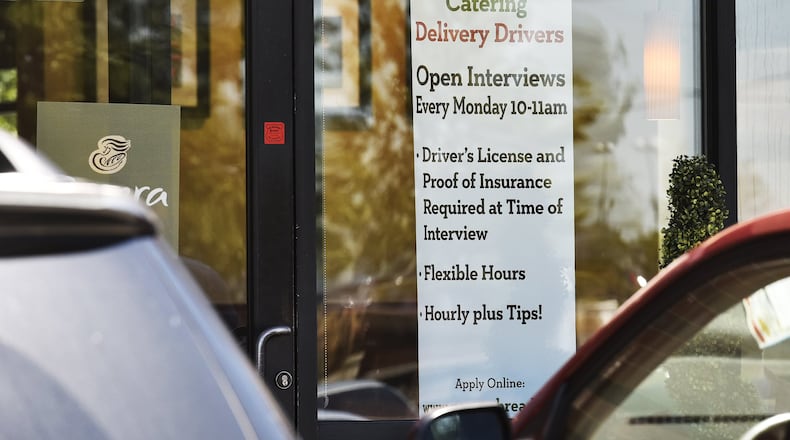RELATED: Panera to deliver at least 120 jobs in Butler, Warren counties
“When Amazon implemented Prime two-day shipping, that was almost unheard of, that you guaranteed two-day shipping to customers,” Jin said, noting next-day and same-day delivery then followed. “Now, all of a sudden, shopping is not just about getting your goods, but instead it’s about the convenience and it’s about the speed.”
Pam Rezai, of Deerfield Twp., said Panera’s new service is something she would frequently use to feed her family as it fills a void left by a shortage of nutrition-friendly take-out options.
“It’s a guaranteed healthy option with a lot of variety,” said Rezai outside the Panera in Voice of America Centre in West Chester Twp. Tuesday afternoon. “Instead of going out to get it, you can just have it sent in.”
MORE: Walmart’s new pickup service arrives at West Chester, Deerfield Twp.
The timing of giants like Walmart, Kroger, Meijer, Panera and others rolling out such efforts now is “the natural progression of the rise of online retailing,” Jin said.
Advances in information technology have made it cost effective for businesses, Jin said.
“Instead of having to have someone dedicated to stay on the phone, where you can take customer orders one at a time, you can actually just allow your system to take orders from the customers and then process it. In effect, it becomes less labor intensive,” he said.
RELATED: Grocery war comes to Butler County
“Consumers are paying more attention to the service elements beyond just the goods element, and so what you see then is the brick-and-mortar retailers are rushing to try and fend off the Amazonification of the entire retails shopping experience,” Jin said.
That experience is becoming increasingly prevalent when it comes to delivery dining. A recent survey conducted by Harris Poll on behalf of digital ordering solutions company OrderTalk Inc. and cited by Modern Restaurant Management found that “94 percent of U.S. adults have ordered takeout and 65 percent order takeout at least once a month. Nearly two thirds of Americans (62 percent) order takeout digitally via an app or website, and of those who have ordered digitally, 67 percent say they prefer to order digitally rather than by phone.”
That’s also why retailer Walmart is trying to adopt omnichannel retailing that allows consumers to purchase and receive the same product in any way desired, from online shopping and in-person shopping to in-person pickup and home delivery, Jin said.
RELATED: What one shopper learned with Kroger’s online shopping
Part of the reason grocery stores accelerated their curbside pickup programs was to keep up with online advances like Amazon Now and Google Express, he said. Part of the reason restaurants in the Cincinnati and Dayton areas started offering delivery service was because app-enabled services like DoorDash recently expanded to the region.
What it’s all boiling down to, Jin said, is retailers accommodating consumers’ desire for them to take over the fulfillment process involved in shopping or dining.
“Effectively, all the consumers need to worry about is ‘I want something and I get something,’” Jin said.
RELATED: Meijer adds home delivery services in Cincinnati, Dayton
Panera, by using an order tracking system powered by Bringg technology, gets to keep its own branding instead of employing the co-branding required by DoorDash, he said.
“It wants to keep its brand identity front and center to the customer, as opposed to letting people think DoorDash is the reason they have the convenience,” Jin said. “This way, Panera can convey to the customers that the convenience you’re enjoying comes from Panera, not from Bringg. It’s part of controlling the experience.”
While restaurants can adapt to online ordering and delivery via apps and additional employees, retailers like Walmart and Kroger have had to modify their storefronts, which were not built with pickup or delivery in mind, Jin said.
That’s why Walmart last week announced it would build online pickup towers in the middle of the store so customers can know where to go to pickup online orders.
As greater technology is tested and becomes available, consumer demand is likely to increase, Jin said. Those technologies will then be refined to be able to deliver more of what consumers want.
“A lot of times, consumers may not even know what they want until somebody presents an experience to them and then they realize ‘Oh yeah. This is really important,’” Jin said. “(With the Panera Delivery), it’s almost like they have a little restaurant to-go in their pocket.”
Panera’s delivery system app allows guests track a delivery order all the way to their home or office, along with expected arrival time, the delivery’s progress on a map, a picture of and introduction to the driver and a notification when that driver is arriving.
“I guess when you’re kids are screaming that they’re starving you can say ‘They’re five minutes away’ instead of saying ‘I don’t know,’” Rezai said.
About the Author

